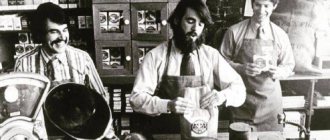The history of coffee goes back to ancient centuries, so until now it has not been possible to obtain accurate information about its origin. Nevertheless, some interesting legends have reached us.
History says that there were many opponents of the introduction of a strong drink into a person’s daily life, but the addiction to the invigorating potion still won. Today, coffee is in second place in sales on the world market and is second only to petroleum products in trade turnover.
The following material will briefly and clearly tell you about the history of coffee.
Different stories of the origin of coffee
There are several versions of the origin of coffee. The first version claims that the drink originated in Ethiopia. And the shepherd Kaldim, who was grazing goats, helped the Ethiopians learn about him. It was he who noticed how animals, after eating the leaves of a wild coffee tree, became overexcited. Kaldim told the abbot of the monastery about the amazing effect of the plant on goats. He became interested in the phenomenon and began to test the effect of the fruit on the body. Noting the invigorating effect of the coffee decoction, the abbot of the monastery began to recommend that his subordinates drink the drink in order to ward off drowsiness while standing in prayer. Local residents, having learned about the coffee tree, learned the recipe from the monks. Thanks to this, the coffee drink that originated in Ethiopia began its march throughout the world.
The second history of coffee remembers the reign of Sheikh Abd al-Qadir. Being a lover of scientific research, the sheikh paid a lot of attention to medicinal plants. Studying coffee as a remedy for headaches and poor bowel function, the sheikh in a written tradition compared it to a source of knowledge.
The next history of coffee concerns the ancestors of the Oromo tribe. It is known that African nomads, having discovered the power of the drink, constantly consumed it as food, and when they settled, they passed on their addiction to the local residents.
As you can see, the history of the discovery of coffee is ambiguous, since each legend offers its own theory of the origin of the drink. Today, only one thing can be said with confidence: the ancestor of the invigorating drink was most likely Ethiopia.
How coffee was discovered
There is more than one story about the discovery of a coffee drink. The origin of coffee is shrouded in myths and legends. According to one version, a shepherd from Ethiopia named Kaldim first noticed the berries. He found that goats became more active after eating these fruits. He wanted to figure out how this effect was achieved, so he took the berries of the coffee tree and poured water over them. The taste of this unusual liquid turned out to be very unpleasant.
Kaldim got upset and threw the branches on which the fruits remained into the fire. After a while, he felt an unusual, pleasant aroma. Immediately after this, the shepherd began collecting grain from the fire. He poured water over them again, waited for them to sit, and tasted the liquid he had prepared. The taste was bitter, quite tart, but pleasant. After a while, a feeling of vigor appeared that lasted almost a day.
The shepherd came up with the idea to tell the abbot of the monastery nearby about the aromatic drink. He was interested in Kaldim's story, and he instructed the novice to collect the berries, fry them in the oven and chop them. After this, the product was poured with boiling water and infused. The abbot really liked this drink. He ordered all the monks to drink it so as not to fall asleep during the night prayers.
The ancient name of the drink is “buno”. This is what the inhabitants of the province where coffee beans were first discovered called it.
Modern “coffee” comes from the region where the trees grow – Kaffa.
History of coffee: briefly about other countries of the world
Everyone knows that the coffee drink first became traditional in Middle Eastern countries. He fell in love with Europe a little later. The first plantation was planted in Yemen, when Arab traders brought raw materials. Next, Istanbul and Cairo became acquainted with the invigorating drink.
In the 15th century, the spread of coffee spread to Libya, Algeria, Morocco and Tunisia. After the destruction of the power of the Ottoman Empire, in the Arab Maghreb states, coffee raw materials from Yemen began to actively move to European countries.
Today, Yemenis proudly call the coffee drink their own. At the same time, they are silent that there was a time when in 1511 in Mecca, at the Council of Lawyers, a curse was placed on coffee in the name of Allah and the use of the “devilish intoxicating potion” was strictly forbidden. The reason for this policy was that with the spread of coffee in Arabia, cozy coffee shops began to open all around, where Arabs spent a lot of time on soft sofas, drinking a drink. Because of this, very little time was devoted to prayers. Then the ban on the drink was very strict; those who disobeyed could be drowned in a coffee bag, their tongue could be cut out. In some cases, people were even executed.
The history of the appearance of coffee in European countries
The famous Italian doctor P. Alpini first wrote a lot about the coffee tree in 1591. The fruits of this tree became interesting to him after a research trip to Egypt. 25 years later, the first cafe appeared in Rome, opened by a representative of the Pope who lived for a long time in Iran. It was a stunning debut, after which Marseille and the beloved Venice took up the development of coffee craftsmanship.
By the middle of the 17th century, there were no townspeople in Europe who could not appreciate the miraculous drink, despite the fact that doctors in many cases did not recommend its use.
The interesting thing is that some coffee shops still exist. Suffice it to recall the famous coffee shop “Cafe Florian”, located on St. Mark’s Square in Venice. It was opened in 1720 and is still in operation.
In 1600, Pope Clement VIII could not resist the strange drink. Wanting to declare it “unclean,” the Lord’s servant decided to try it. The clergyman was so fascinated by the drink that he could not impose a ban on it.
The first coffee shop in England was opened by the Turk Pasca Rosi in Oxford in 1659. After which, English doctors universally advised drinking the aromatic drink, prescribing it for hysterics, stomach diseases, and also in cases where it was necessary to stimulate mental work.
Few people know that the history of coffee in Great Britain also contains memories of curious incidents. It is known that in 1674 only men were allowed to visit coffee houses. As a result, the women prepared a serious petition in which they condemned the use of coffee, because of which “husbands became eunuchs and gallant gentlemen lost their gallantry.” The men, having learned about such a petition, became ardent defenders of the slandered drink. The worried Charles II, having read the women's petition, issued a decree to close all coffee shops. But the decree was not executed, since the ruler quickly recalled it, fearing a wave of discontent among the stronger sex.
Cafe "Pechkina" - a meeting place for creative bohemia
At the beginning of the 19th century, the famous Pechkina cafe opened in Moscow. The cafe had 5 rooms; visitors could not only drink a cup of coffee, but also play billiards and read the latest magazines. Pechkin's cafe has become a meeting place for creative bohemia. Famous writers, actors, musicians, artists came here to find out news and communicate - Vissarion Belinsky, Alexander Herzen, Timofey Granovsky, Mikhail Bakunin, Mitrofan Shchepkin, P. Molchanov, A. Ostrovsky. About this club-coffee shop, Alexey Pisemsky wrote: “The most intelligent and thoughtful place in Moscow,” and the poet Afanasy Fet liked to say: “Who knows how much love for science and art Pechkin’s cafe radiated.”
History of coffee in Russia
The spread of the coffee drink dates back to the reign of Peter I. Having tried Dutch coffee, the emperor introduced the tradition of drinking it at meetings.
Back in 1740, the opening of the coffee house was initiated by Empress Anna Ioannovna. The first Moscow coffee shop “Pechkina” opened in the capital at the end of the 19th century. The bohemian public of that time called it a “reasonable place.”
Today our state is one of the ten countries where the described drink is very actively consumed. Statistics show that 85% of imported products come from the instant drink described.
History of the coffee drink: interesting facts about terminology
In England, the term "coffee" appeared in 1598. The British claim that they borrowed this word from the Dutch word koffie. Europeans say that they borrowed the name of the drink from the Turkish name kahve.
Ethiopians claim that the miraculous grain received its name due to the area where it grew (this is the Kaffa region).
An interesting fact is that Russians pronounce coffee (“coffee”) in the masculine gender. It has been this way since the time of Peter the Great.
As you can see, the history of coffee creation contains many secrets, as well as heated debates. It reflects years of tragic events and a period of intense interest in this drink. But be that as it may, the global popularity of coffee has been maintained for several centuries. And this is not surprising, because the magnificent taste and amazing smell of the drink excite the mind and remind us of the bohemian life of aristocrats.
The origins of coffee culture
The history of coffee is the fascinating journey of the coffee bean from the African continent through the Red Sea to Arabia, to the East, to Europe and the New World.
Wild coffee from Ethiopia was brought by the Arabs, constantly seeking to expand their horizons, to Yemen, from where sailors from the Old World brought it to North and South America and the East Indies. Coffee trees took root well in warm foreign lands.
And in the city of Mokha in Yemen, the first coffee plantations appeared, which for two centuries supplied the entire East with excellent coffee, named mocha in honor of the city. We can safely say that it was here in the 12th century that the first sprouts of real coffee culture appeared.
At one time, coffee was even banned in the Islamic world: it became so popular that it distracted the faithful from prayers.
The Arabs saw great benefits in the enchanting drink that won the hearts of many people, and decided to introduce it to the whole world. The coffee trade in India and Europe flourished.
The birth of coffee
From the discovery of the power of coffee by the Kaldima goats until the 14th century, there were numerous changes in coffee preparation. First there was a decoction from the leaves of the coffee tree, then - wine from fermented berries. Then the coffee beans were roasted and ground, and milk and spices - cloves, cinnamon, cardamom - were added to the drink made from them.
Along European roads: the history of the emergence of coffee in Europe
Italy was the first European country to learn about coffee. And in Venice in 1646, the first coffee shop in Europe opened.
Along with the Italians, the ubiquitous Dutch merchants also began to master the curiosity. They not only brought it to other countries, but also began to grow it on the islands of Java and Ceylon.
In 1652, the first coffee shop opened in London.
Coffee in French
It is interesting that in France the drink, so beloved by many Europeans, did not immediately take root. Proud Paris was 20 years late. They started drinking coffee in France in 1669, during the reign of Louis XIV, who, by the way, loved to brew coffee with his own hands, and the first coffee shop opened in the country only in 1672. But today the French are one of the most incorrigible coffee lovers in Europe. Wine merchants called coffee “soot dissolved in water.” But their black PR was in vain: the aroma of coffee beans bewitched the hearts of the French.
German coffee boom
The coffee business developed so successfully in Germany that the Prussian King Frederick monopolized it and introduced a very unusual position - “sniffer”. These people walked the streets in search of illegal dryers, literally sniffing out whether the coffee spirit was wafting from secret storage areas. True, the poor fellows got it from malicious violators: serious injuries were not uncommon.
In 1675, the first coffee houses appeared in Hanover, Bremen and Hamburg. In 1721, a coffee house was opened in Berlin.
In 1680, coffee entered the Scandinavian countries.
Discovery of America
At the beginning of the 18th century, coffee “moved” to the New World. The first coffee tree was planted on the island of Martinique in the Caribbean by French colonialists, from where it spread throughout the tropics of Central and South America.
In 1727, the Brazilian coffee industry began to develop. In 1730, coffee trees were brought to Jamaica by the British, and in 1731, thanks to the Spaniards, they appeared on the island of Santo Domingo.
Coffee began to be grown in Venezuela in 1784, and in Mexico in 1790.
The first coffee makers and coffee machines were invented in the first half of the 19th century.
In 1896, coffee trees were planted by the British in distant Australia.
Flavored coffee was introduced in 1970.
Second birth
In 1819, caffeine was isolated from coffee extract. The discovery of the French scientist Runge became the second birth of coffee: since then it began to be used as a medicine. Nowadays, caffeine is included in many medications and is successfully used to combat a number of ailments. It is interesting that in England they began to prepare a paste from ground coffee, ghee and honey back in the 17th century: it was considered an excellent medicine.











